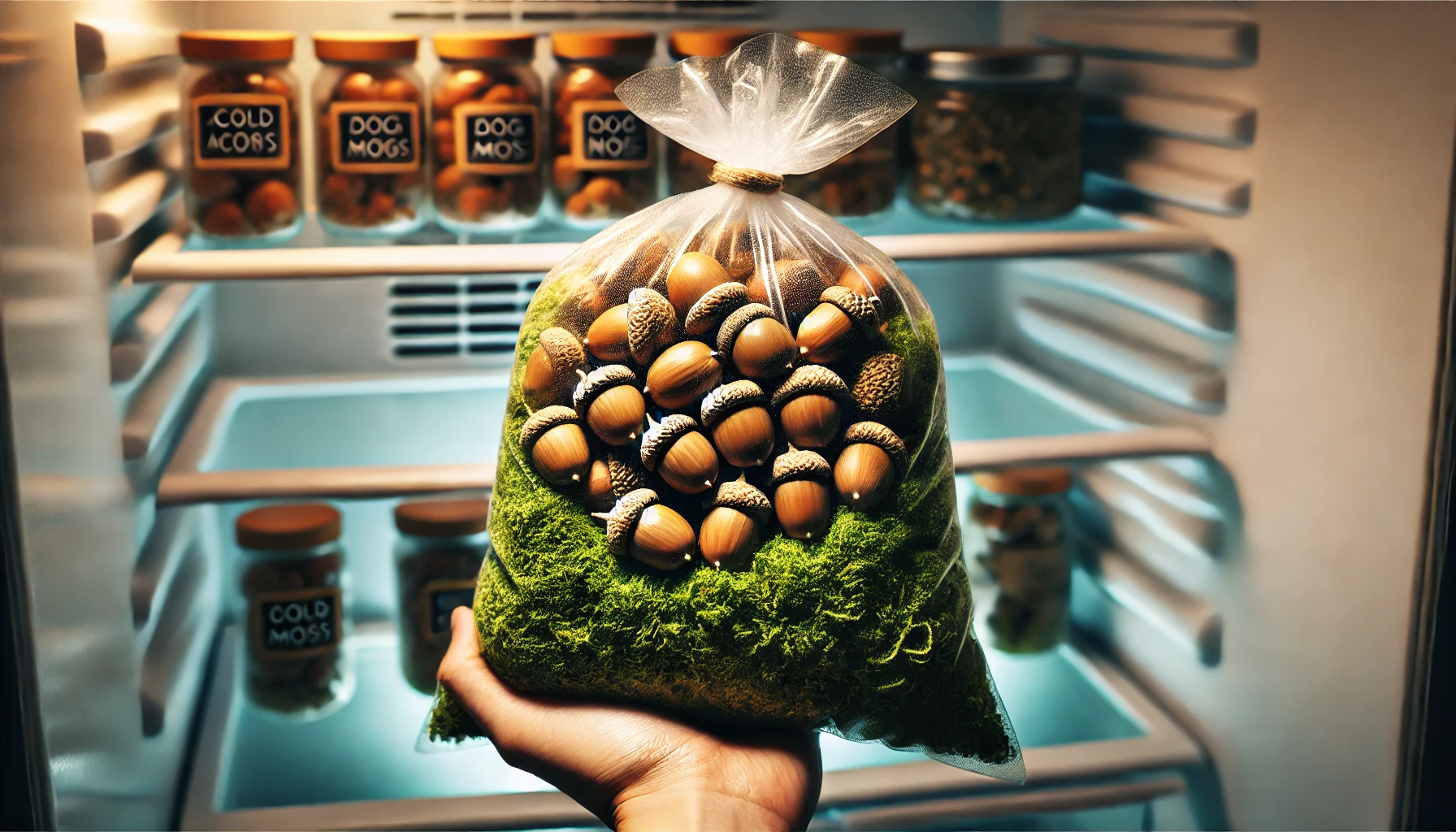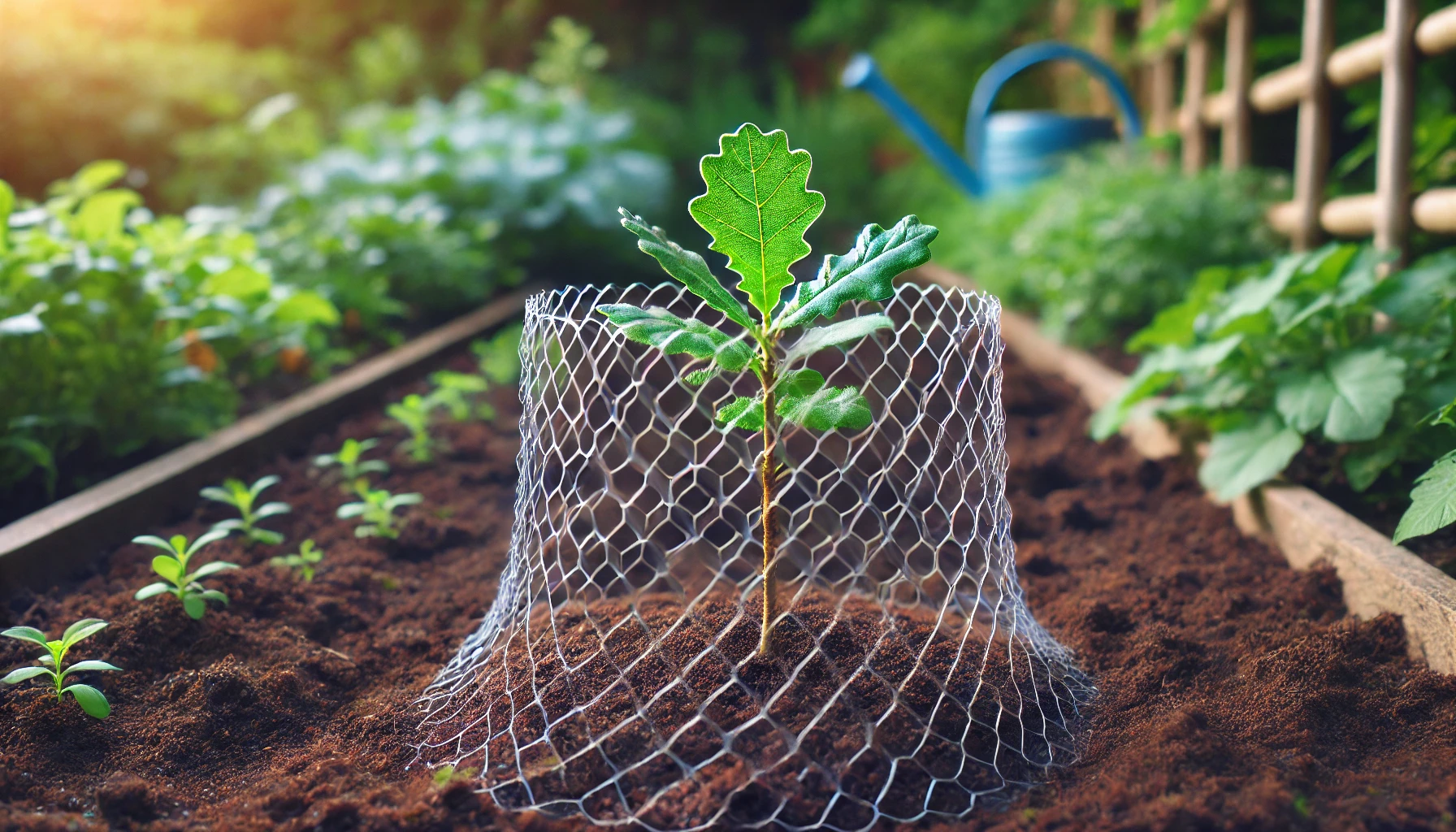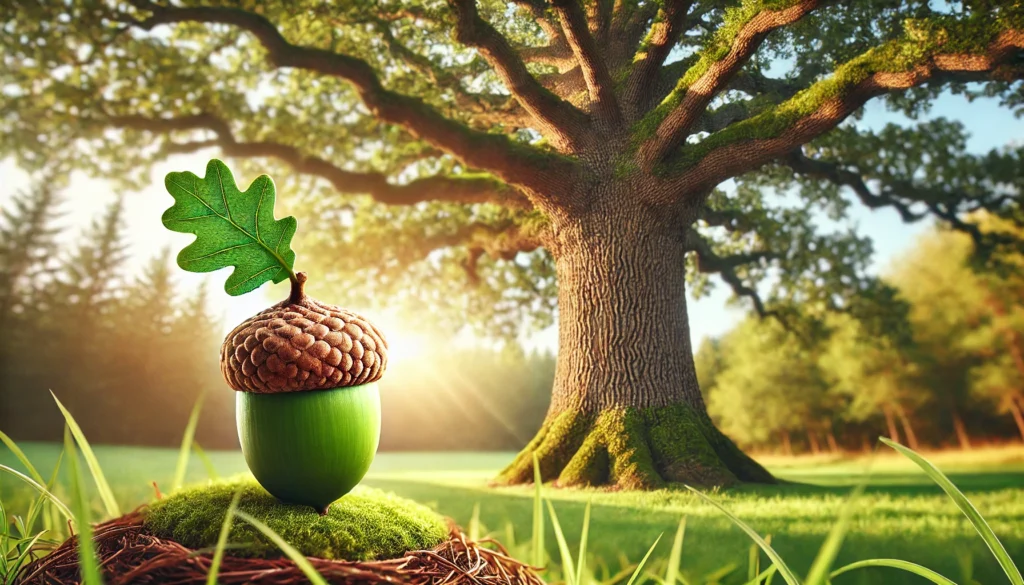
How to Grow Oak Tree Seeds: A Step-by-Step Guide for Successful Planting and Care
Growing an oak tree from seed might seem like a daunting task, but with the right guidance, it’s entirely possible to create a majestic tree right in your own backyard 
In this step-by-step guide, we’ll walk you through everything you need to know about planting and caring for oak tree seeds. From selecting the right seeds to ensuring their growth and survival, you’ll gain the confidence to transform tiny acorns into towering oak trees. Ready to get started? Keep reading to learn the secrets of growing oak trees like a pro!
Table of Contents
ToggleWhy Grow Oak Tree Seeds? 
Growing oak tree seeds offers many exciting benefits, whether you’re a seasoned gardener or a complete beginner. Oak trees are not just beautiful additions to your landscape; they also provide ecological value, long-lasting beauty, and a connection to nature. Here’s why you should consider growing oak tree seeds:
1. Sustainability & Environmental Impact 
Oak trees are known for their longevity and ability to improve the environment. As a fast-growing hardwood, they help reduce carbon dioxide levels in the air, providing cleaner air for everyone. Planting oak trees contributes to the fight against climate change by acting as carbon sinks, making them an eco-friendly choice.

2. Attractive and Strong Trees 
Oaks are admired for their majestic appearance. With their wide canopies, strong branches, and beautiful fall foliage, oak trees add elegance to any landscape. These trees also grow strong, with deep roots that help prevent soil erosion—making them great for stabilizing areas that might otherwise be prone to land degradation.
3. Wildlife Habitat 
Oak trees play an essential role in the ecosystem. They support a wide range of wildlife, from squirrels to deer to various bird species. The acorns that oak trees produce are a food source for many animals, making them an essential part of a healthy ecosystem. By growing oak trees, you’re not just adding beauty to your yard—you’re also supporting local wildlife.
4. Longevity and Legacy 
Oak trees can live for hundreds of years, making them a lasting gift for future generations. When you plant an oak tree from seed, you’re not only creating a personal legacy, but you’re also contributing to a larger environmental legacy. Oaks are a perfect choice if you want to plant something that will stand the test of time.
5. Educational Experience 
Growing oak trees from seeds can be a fun and educational experience for you and your family. From planting the acorns to watching them grow into towering trees, this process teaches patience, responsibility, and an appreciation for nature. It’s also a great opportunity for children to learn about the life cycle of trees and the importance of trees in the environment.
6. Low Maintenance, High Reward 
Oak trees are relatively low-maintenance once established. While the first few years may require some care, once the tree is established, it thrives in various soil types and climates. Whether you’re a busy homeowner or an enthusiastic gardener, oak trees provide significant returns on minimal investment.
Planting oak tree seeds is a win-win. You’re helping the environment, beautifying your space, supporting wildlife, and creating a lasting legacy. Ready to get started? Let’s dive into how you can grow oak tree seeds successfully!
Understanding Oak Tree Seeds 
When you decide to grow an oak tree, the journey starts with the seed. But what exactly are oak tree seeds, and how can you make the most of them? Let’s break it down in simple terms so you can get started on the right foot!
What Are Oak Tree Seeds? 
Oak trees produce acorns, which are the seeds of the tree. These small, nut-like structures are packed with potential to grow into mighty oak trees. The acorn contains everything needed to sprout into a young tree, but it requires the right conditions to succeed.
Acorns vary in size, shape, and color depending on the oak species. The most common oak species include white oaks and red oaks, and each type has its unique acorn characteristics.
The Anatomy of an Acorn 
Before planting, it’s helpful to understand an acorn’s anatomy. Here’s a quick breakdown:
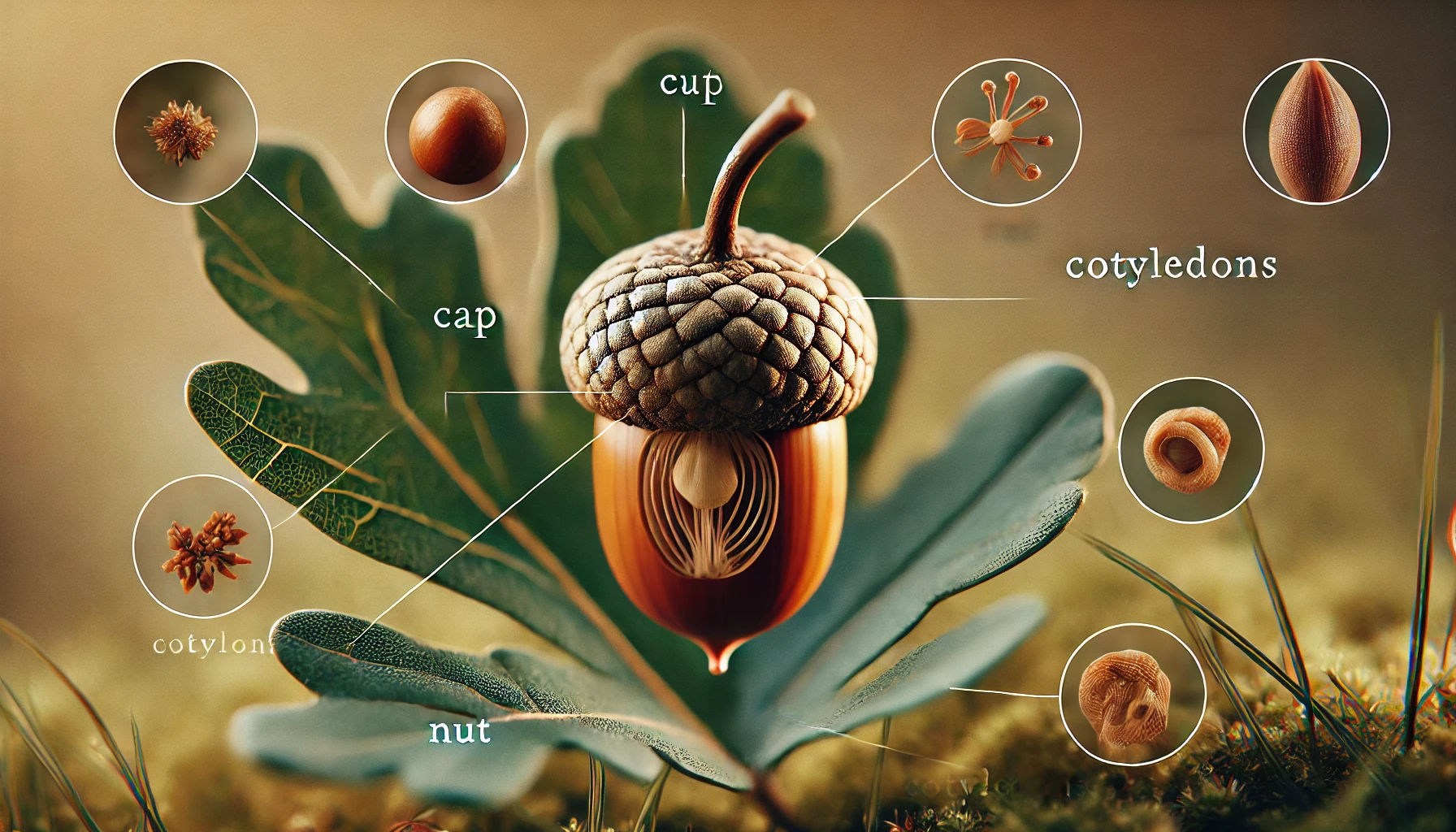
- Cap (Cupule): The brown, scaly top that partially covers the acorn. It provides protection to the seed.
- Nut (Seed): The edible part inside the acorn that holds the genetic material for the new tree.
- Cotyledons: These are the first leaves that appear when the seed begins to grow. They store energy and help the seedling get started.
How to Identify Healthy Acorns 
Not all acorns are suitable for planting. Here’s how to choose the best ones:
- Look for Firm Acorns: Choose acorns that feel solid and heavy. Light or soft acorns are likely damaged or empty.
- Inspect the Cap: Ensure the cap is firmly attached. If it’s loose or missing, the acorn may not be viable.
- Water Test: To test viability, place the acorns in a bowl of water. Healthy acorns will sink, while damaged ones float.
When Do Oak Trees Drop Acorns? 
Most oak trees produce acorns in the fall, with the peak time typically between September and November. This is the best time to collect acorns for planting, as they are mature and ready for germination. Timing is important—if you wait too long, acorns may begin to lose their viability.
How Long Do Acorns Stay Viable? 
Acorns don’t last forever. Their viability depends on how they are stored. If stored in a cool, dry place, they can remain viable for several months, but it’s best to plant them as soon as possible for the best results.
In some cases, acorns can be stored in a refrigerator for up to a few months, but you’ll need to check them regularly to ensure they haven’t dried out or become moldy.
Why Is Understanding Oak Tree Seeds Important? 
By understanding the basics of oak tree seeds—what they are, how to identify healthy ones, and when they’re ready to plant—you can dramatically improve your chances of successfully growing an oak tree. It’s all about starting with the right seed! Whether you’re starting from scratch or adding to your landscape, knowing the right acorn to plant and when to do so makes all the difference.
Stay tuned for the next step, where we’ll dive into how to plant your oak seeds for maximum success!
Choosing the Right Oak Tree Seeds for Your Area 
When it comes to growing oak trees, selecting the right seeds for your area is one of the most crucial steps in ensuring successful growth. Oak trees are hardy and adaptable, but different species thrive better in different environments. Here’s a simple guide to help you pick the right oak tree seeds for your location.
1. Understand Your Climate 

The first thing to consider is the climate in your area. Oak trees generally fall into two categories: red oaks and white oaks.
- Red oaks (like the Northern Red Oak) prefer cooler climates with colder winters.
- White oaks (such as the Bur Oak) thrive in more temperate zones with moderate winters.
Before selecting seeds, check your USDA hardiness zone, which will help you determine which oak species will do best. This zone map divides regions based on temperature ranges and can be easily found online.
2. Consider Soil Type 
Oaks are known for their deep roots, so soil quality plays a big role in their success. Some oak species prefer well-draining, loamy soils, while others can handle clayey or rocky soils. Here’s a breakdown:
- Red oaks tend to do well in loamy or sandy soils.
- White oaks are more versatile and can tolerate a wider variety of soil types, including heavier clay.
Check your soil type before planting, and choose seeds that will thrive in your soil’s specific conditions.
3. Research Local Oak Species 
Native oak species are often the best choice for your area because they are naturally adapted to your local conditions. Local species are also better for supporting local wildlife and promoting biodiversity. If you’re unsure about the species in your region, consult local gardening centers, forestry departments, or local nature reserves for guidance.
Here are a few common native oaks by region:
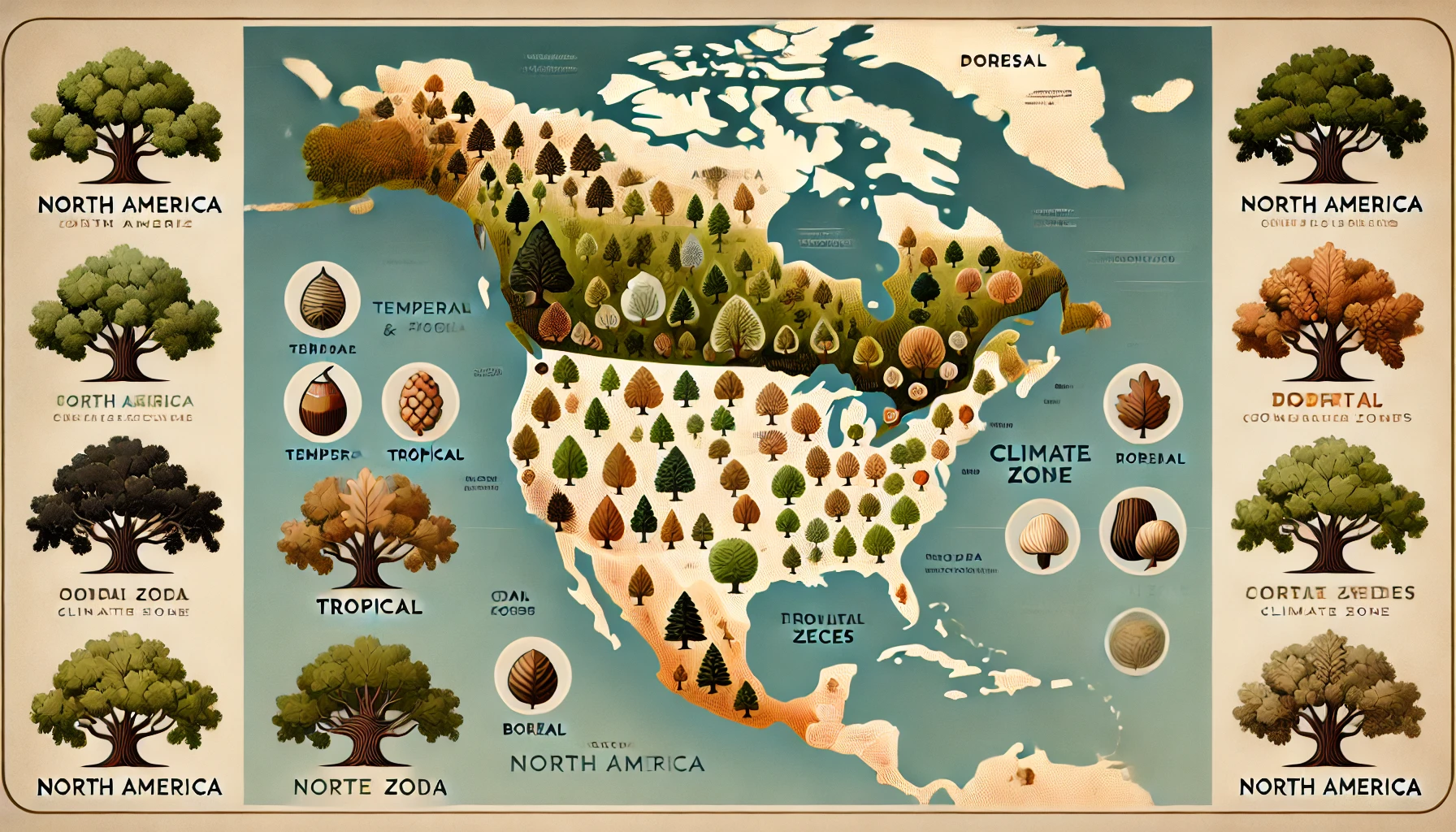
- Eastern United States: White Oak, Northern Red Oak
- Western United States: California Black Oak, Valley Oak
- Southern United States: Southern Red Oak, Live Oak
4. Think About Growth Rate 

If you’re looking for fast growth, some oak species grow faster than others. Red oaks tend to grow quicker than white oaks, but they may not live as long. White oaks grow slower but can reach impressive heights over time. Choose the growth rate that matches your expectations for your oak tree’s development.
5. Consider Local Pests and Diseases 
Some oak species are more resistant to local pests and diseases than others. For example, the Bur Oak is often resistant to oak wilt, a common disease that affects other oak species. Check with local forestry experts to find out which oak varieties are known to be more resilient in your region.
6. Availability of Seeds 
Not all oak species are available in seed form at every garden center. Some might be more commonly found as saplings or seedlings. If you’re set on starting from seed, make sure to source them from reputable suppliers who offer fresh, high-quality seeds. Local nurseries or online resources that specialize in native plants are often great places to look.
Final Thoughts 
Choosing the right oak tree seeds for your area is key to ensuring a healthy, thriving tree in the years to come. By considering your local climate, soil type, native species, growth rate, and pest resistance, you’ll set yourself up for success.
Happy planting, and enjoy watching your oak tree grow!
Preparing Oak Tree Seeds for Planting
When it comes to growing oak trees from seeds, preparation is key to ensure the best possible start for your future oak tree 
1. Collect the Seeds
The first step is gathering acorns, which are the seeds of oak trees. Aim to collect them during the fall, typically from September to October, when they’re fully matured. Choose acorns that are brown and free of cracks, holes, or mold. Healthy acorns are essential for strong, healthy oak trees 
2. Test the Acorns
Before planting, you want to make sure your acorns are viable. To do this, you can perform a quick float test:
- Fill a bowl with water and drop your acorns in.
- Healthy acorns will sink, while those that float are likely damaged or dried out. Discard any floating acorns, as they won’t germinate effectively.
3. Remove the Caps
Once you have the viable acorns, gently remove the caps. This is an optional step, but removing them can help with easier seedling emergence when planting. If the caps are difficult to remove, leave them on—nature will still take its course.
4. Scarify (Optional but Recommended)
Oak acorns have a tough outer shell that may prevent them from germinating right away. Scarifying, or gently nicking the seed coat with a knife or sandpaper, can help break through this barrier and speed up germination. Be careful not to damage the inner seed! This step is especially useful if you’re working with acorns that have a particularly hard shell.
5. Stratify the Seeds (Cold Treatment)
Oak seeds require a period of cold stratification to mimic winter conditions, which encourages germination. Here’s how to do it:
- Place the acorns in a plastic bag with some damp sphagnum moss, sand, or potting mix.
- Seal the bag and store it in the refrigerator for 30-60 days. This cold treatment will trick the seeds into thinking they’ve gone through winter, preparing them to sprout in the spring
.
6. Check Periodically
During the cold stratification process, check your acorns every two weeks to make sure the growing medium remains damp but not soaking wet. This will prevent the seeds from drying out or molding. After 30-60 days, you’ll be ready to plant your acorns!
7. Prepare for Planting
Once your acorns have gone through stratification, you’re ready to plant them! Select a suitable location with well-draining soil, plenty of sunlight, and enough space for the oak tree to grow. Oak trees can get quite large, so make sure there’s room for them to spread their roots and canopy.
With these simple steps, you’ll be well on your way to growing a mighty oak tree from seed 
Planting Oak Tree Seeds 
Planting oak tree seeds, also known as acorns, is an exciting and rewarding process. Whether you’re looking to grow a majestic oak tree in your backyard or start a small forest, following the right steps can ensure your success. Here’s a simple guide on how to plant oak tree seeds like a pro!
1. Choose the Right Acorns 
Not all acorns are created equal. When selecting acorns for planting, make sure they are from a healthy oak tree. Look for acorns that are brown and firm to the touch—avoid any that are soft, cracked, or have visible holes, as these are often signs of pests or disease.
2. Prepare the Acorns for Planting 
Acorns need a period of cold treatment (called stratification) to break their dormancy and sprout. This process mimics the cold winter months, which is essential for germination. Here’s how to do it:
- Cold Stratification: Place your acorns in a plastic bag with some moist peat moss or sand. Store the bag in the fridge for about 30-60 days. Check the acorns regularly to make sure they are still moist but not soaking wet.
- Test for Viability: Before planting, float the acorns in water. Discard any that float—these are likely to be non-viable. The ones that sink are your best bet for successful growth.
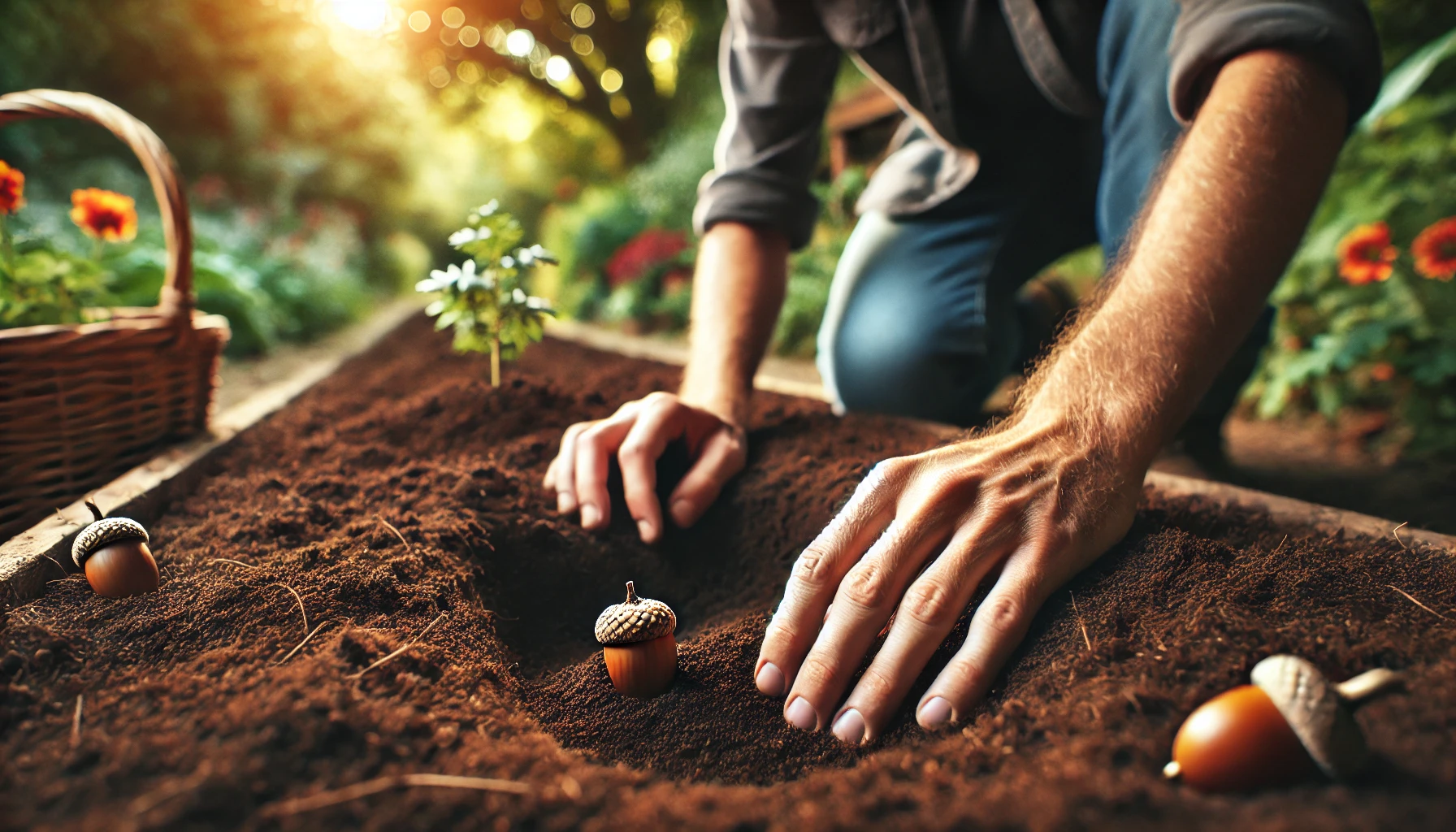
3. Choose the Right Planting Location 
Oak trees prefer full sunlight, so pick a spot with at least 6 hours of direct sunlight each day. The soil should be well-draining and slightly acidic to neutral. Avoid areas with heavy clay or compacted soil, as these can restrict root growth.
4. Planting the Acorn 
Now it’s time to plant your acorns! Here’s how:
- Dig a Hole: Create a small hole about 1-2 inches deep (2-5 cm). You don’t need to plant the acorn too deep—it’s important to leave some room for it to sprout and grow.
- Place the Acorn: Drop the acorn into the hole with the pointed end facing down. This will help the roots grow downward and the stem grow upward.
- Cover the Acorn: Gently cover the acorn with soil, patting it down lightly. Make sure the soil is not too packed, as this could prevent the seed from sprouting.
5. Watering 
Once planted, water the area well. Keep the soil consistently moist, but avoid over-watering. If the soil is too soggy, the acorn might rot before it can sprout. Watering should be done regularly, especially during dry spells.
6. Protect the Seeds 
Acorns are a delicious treat for squirrels, deer, and other wildlife. To ensure your seeds don’t disappear, consider placing a small mesh or wire cage around your planting area. This will prevent animals from digging up your acorns and give them a better chance to grow.
7. Watch for Germination 
In about 6-12 weeks, you should start to see your acorns sprouting small roots and shoots. As the seedlings grow, gradually remove any protective coverings, and be sure to keep the soil moist during the early stages of growth.
8. Caring for Young Oak Trees 
Once your oak tree seedlings are well-established, they will need occasional care to thrive. Keep the area free from weeds, and water them during dry periods. Over time, the young trees will become more drought-tolerant and require less maintenance.
Final Thoughts
Planting oak tree seeds is a simple yet rewarding task that, with patience and care, can result in a magnificent tree for years to come. By following these steps, you’ll be well on your way to growing a strong, healthy oak tree. 
Caring for Oak Tree Seedlings 
Growing oak tree seedlings can be an incredibly rewarding experience, but it requires the right care to ensure they thrive. If you’ve successfully sprouted your oak tree seeds, the next step is nurturing your young seedlings into healthy, strong trees. Here’s a straightforward guide to caring for oak tree seedlings, so they grow strong and healthy!
1. Transplanting Your Seedlings 
Once your oak seedlings have grown strong enough to handle a little more space, it’s time to transplant them. Choose a location with well-draining soil and plenty of sunlight. Oak trees love full sun, so aim for 6-8 hours of direct sunlight per day. When transplanting, make sure to handle the seedlings gently to avoid damaging their roots.
2. Watering Needs 
Oak seedlings need consistent moisture, especially when they are young. Water the seedlings deeply and regularly, ensuring that the soil stays moist but not waterlogged. Avoid shallow watering, as it can cause the roots to stay near the surface, where they are more vulnerable. A good rule of thumb is to water when the top 1-2 inches of soil feel dry to the touch.
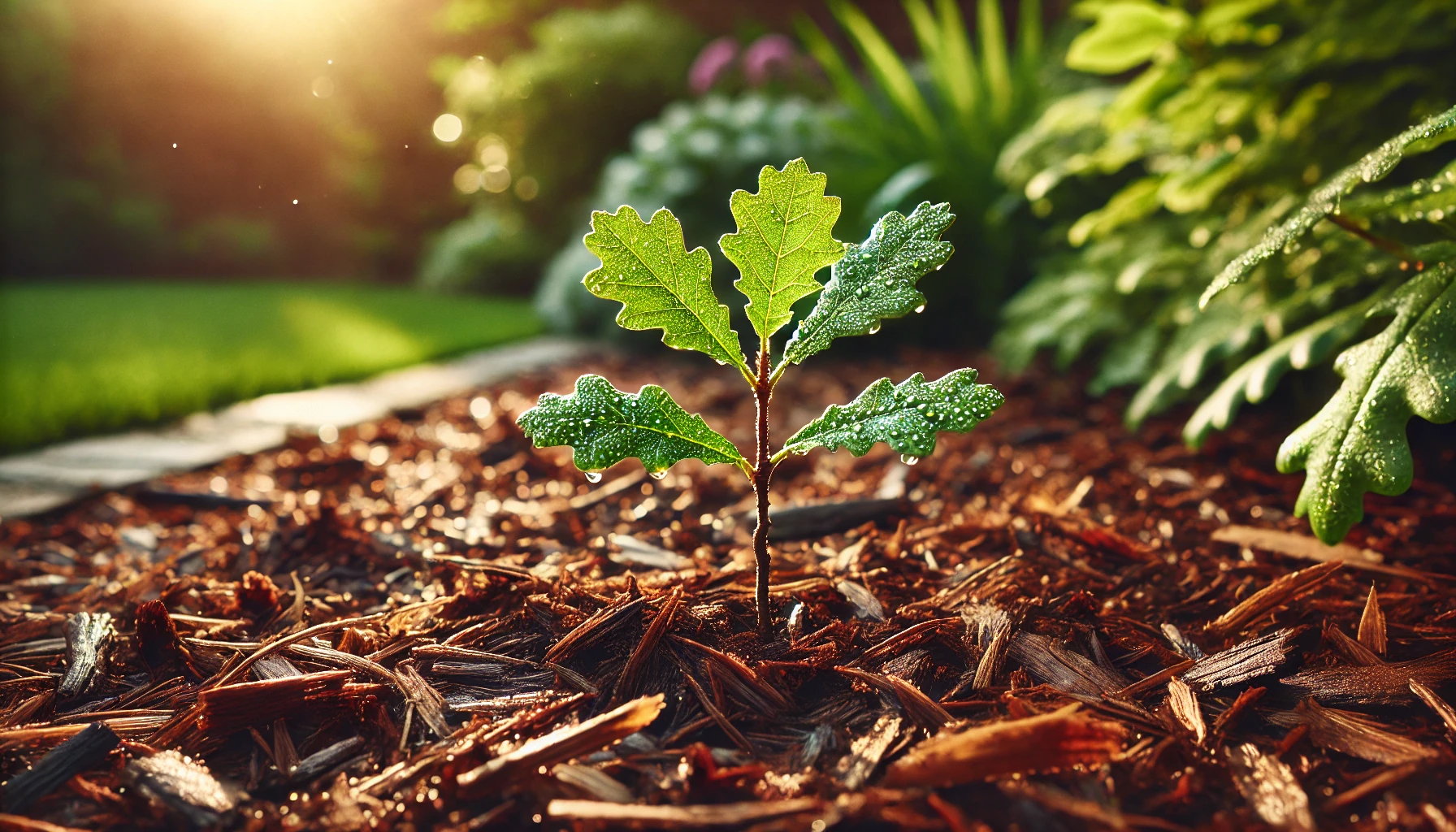
3. Mulching for Protection 
Mulch is your best friend when it comes to caring for oak tree seedlings. A 2-inch layer of organic mulch around the base of the seedling helps retain moisture, suppress weeds, and regulate soil temperature. It also protects young roots from the harsh summer sun and helps to prevent soil erosion.
4. Fertilizing Sparingly 
Young oak trees don’t require heavy fertilization. In fact, too much fertilizer can damage the roots. Instead, use a balanced, slow-release fertilizer once a year in early spring, when the tree is actively growing. If you prefer organic options, compost or well-rotted manure can also provide essential nutrients without overwhelming the plant.
5. Pruning for Shape 
While pruning isn’t absolutely necessary for young oak seedlings, it can help guide their growth. Remove any dead, damaged, or weak branches as they appear. This will encourage stronger growth and better air circulation. Avoid heavy pruning until the tree is more established, as young trees are still developing their structure.
6. Protecting from Pests 
Oak seedlings can be vulnerable to pests, especially when they’re young. Keep an eye out for common threats like aphids, caterpillars, and beetles. Organic insecticidal soap or neem oil can help control pests without harming the seedlings or the environment. Be sure to inspect your seedlings regularly for any signs of damage.
7. Keeping Your Seedlings Safe from Harsh Conditions 
Oak seedlings are generally hardy, but extreme weather can still take a toll. During winter, protect young seedlings from frost by wrapping the trunk with burlap or using a protective tree guard. If you live in an area with heavy snow, ensure that the seedlings are well-supported and won’t be crushed by the weight of snow or ice.
8. Patience is Key 
Oak trees are slow growers, so patience is essential. It may take several years for your oak seedling to grow into a mature tree, but with consistent care and attention, it will eventually reach its full potential. The reward will be a magnificent oak tree that can last for generations!
Final Thoughts
Caring for oak tree seedlings may seem like a lot of work, but it’s truly worth the effort. By giving your young oak tree the right environment, water, and protection, you’ll be setting the stage for a beautiful, thriving oak tree for years to come. Stay committed, and watch your seedling transform into a mighty oak!
Common Challenges and How to Overcome Them 
Growing oak tree seeds can be a rewarding experience, but it’s not without its challenges. Whether you’re a seasoned gardener or a beginner, encountering a few obstacles along the way is part of the journey. Here’s a breakdown of common issues and how to tackle them effectively:
1. Poor Germination Rates 
Problem: Not all oak seeds will germinate, and it can be frustrating when your efforts don’t seem to yield results. This could happen due to improper storage or planting techniques.
Solution: To improve germination:
- Use Fresh Seeds: Collect seeds from healthy oak trees and plant them within a year. Older seeds lose viability over time.
- Stratify the Seeds: Oak seeds need a cold period to break dormancy. Place them in a damp paper towel inside a plastic bag and refrigerate for 30-60 days before planting. This simulates winter conditions and helps the seeds sprout.
- Soak Before Planting: Soak seeds in water for 24 hours to soften the hard outer shell, allowing them to absorb moisture more easily.
2. Pests and Animals Eating the Seeds 
Problem: Squirrels, birds, and other animals love oak seeds! This can quickly reduce your planting efforts, especially if you’re sowing them outdoors.
Solution: Protect your seeds by:
- Using Mesh or Netting: Cover your seed containers with mesh or netting to keep animals out.
- Planting in Covered Areas: If planting outdoors, choose spots where animals are less likely to dig up seeds, like near a fence or inside garden beds.
- Creating Distractions: Plant extra seeds or offer alternative food sources (like bird feeders) to lure animals away from your oak seeds.
3. Seedling Rot or Mold 
Problem: Overwatering or poor drainage can lead to mold or seedling rot, which can kill your young oak plants before they have a chance to grow.
Solution:
- Well-Drained Soil: Ensure the soil you plant in drains well. You can improve drainage by adding sand or organic matter to the soil.
- Water Properly: Water your seedlings only when the soil feels dry to the touch. Avoid leaving them sitting in water.
- Increase Air Circulation: If growing indoors, make sure there’s enough airflow around your seedlings to prevent mold growth.
4. Slow Growth 
Problem: Oak trees can be slow to grow, especially during the first few years. This can lead to impatience and frustration, but it’s a natural part of their growth cycle.
Solution:
- Give Them Time: Oaks are slow-growing by nature. Patience is key! In the early stages, focus on providing the best conditions, like plenty of sunlight and appropriate watering, and they will thrive in time.
- Fertilize Carefully: Use a balanced, slow-release fertilizer in the spring to give your oak trees the nutrients they need without overwhelming them.
- Control Weeds: Keep the area around your seedlings free of weeds that may compete for nutrients and water.
5. Unpredictable Weather 
Problem: Oak trees are sensitive to extreme weather conditions like late frosts or drought. These can harm young seedlings or delay their growth.
Solution:
- Choose the Right Planting Time: Plant your seeds after the last frost in spring to avoid exposure to cold temperatures.
- Mulch for Protection: Apply mulch around your seedlings to protect their roots from extreme temperatures and retain moisture.
- Water During Dry Spells: Ensure your young oak trees get enough water during dry periods. Deep watering is better than frequent shallow watering, as it encourages deeper root growth.
6. Transplant Shock 
Problem: Moving oak seedlings can stress them out, slowing their growth or causing them to die off entirely.
Solution:
- Transplant with Care: When it’s time to move your oak trees to a permanent location, do so carefully. Try to minimize root disturbance by gently removing the seedling with as much of the root system intact as possible.
- Water Before and After Transplanting: Keep the soil around the seedling moist before and after the transplant to reduce stress and promote recovery.
- Provide Temporary Shade: After transplanting, provide some shade to protect young oaks from the sun while they establish their new root system.
By understanding these common challenges and how to handle them, you’ll set yourself up for success in growing oak tree seeds. 
Transplanting Oak Seedlings 
Transplanting oak seedlings from your nursery or seed-starting pots to their permanent outdoor location is a critical step in ensuring your oak tree thrives. Whether you’re moving saplings from indoors or a nursery, the process is fairly straightforward—but timing and care are essential for success.
1. When to Transplant 
The best time to transplant oak seedlings is during the early spring or fall when the weather is mild. Avoid transplanting during extreme heat or cold, as these conditions can shock young trees and hinder their growth.

2. Prepare the Planting Site 
Choose a spot with plenty of sunlight—oak trees thrive in full sun. Make sure the soil is well-drained and fertile, as oaks prefer slightly acidic to neutral soil. Test the soil pH if you’re unsure, and amend it if needed. Dig a hole about twice the size of the seedling’s root ball to give the roots room to expand.
3. Handle with Care 
Gently remove the oak seedling from its pot or nursery container. Be careful not to damage the roots. If the roots are tangled or circling the root ball, carefully loosen them. This encourages the roots to spread out into the soil instead of staying confined.
4. Planting the Seedling 
Place the seedling in the hole, ensuring the top of the root ball is level with the surrounding soil. This helps prevent water from collecting around the stem, which can cause rot. Fill in the hole with soil and lightly tamp it down to remove air pockets.
5. Water Thoroughly 
After transplanting, water the seedling generously to settle the soil around the roots. Keep the soil consistently moist for the first few weeks until the oak becomes established. Deep watering is preferred to encourage root growth deep into the soil.
6. Mulch for Protection 
Add a 2–3 inch layer of mulch around the base of the tree, but be careful not to let it touch the trunk. Mulch helps retain moisture, regulate temperature, and prevent weeds. It’s a simple yet effective way to support your oak’s growth.
7. Post-Transplant Care 
Continue to monitor your seedling closely for the first few months. If you’re in a dry climate, consider setting up a simple watering schedule. Protect young oak trees from strong winds and harsh sunlight with a temporary shade cloth if needed.
By following these steps, you’re setting your oak seedling up for a healthy and successful future! 
Conclusion
Growing oak tree seeds from scratch is a rewarding and sustainable way to contribute to the environment, while also creating a lasting legacy for future generations. Whether you’re planting a small oak tree in your backyard or starting a larger tree-planting project, following the step-by-step guide in this article ensures that you have all the tools and knowledge to succeed.

By selecting the right oak tree seeds, preparing them properly, and caring for your seedlings with patience and dedication, you’re setting yourself up for success. It may take time for your acorns to grow into towering oak trees, but the journey is well worth the effort.
Now that you have all the tips and techniques needed to grow your oak tree seeds into thriving saplings, it’s time to get started. Take action today—plant your seeds, nurture them, and enjoy the process of watching your oak tree grow tall and strong.
Ready to grow your own oak trees? Share your progress, ask questions, or leave a comment below—let’s keep the conversation going and support each other in this green journey!
Frequently Asked Questions(FAQ)
How long does it take for oak tree seeds to grow into a tree?
It typically takes 3-5 years for oak tree seeds to grow into small saplings, depending on factors like the species, climate, and growing conditions. Oak trees grow slowly but steadily, with significant growth happening after the first few years.
When is the best time to plant oak tree seeds?
The best time to plant oak tree seeds is in the fall, as acorns naturally drop from trees during this season. If you’re starting them indoors, plant them in late winter or early spring after stratification.
How do I know if an acorn is viable for planting?
To check if an acorn is viable, do the float test: place the acorn in water for 24 hours. Viable acorns will sink to the bottom, while damaged or non-viable acorns will float.
Do oak tree seeds need cold stratification before planting?
Yes, some oak species, like Red Oak, require cold stratification to break dormancy. To do this, place the acorns in a plastic bag with moist sand and store them in the fridge for 30-60 days before planting.
Can I grow oak trees in pots or containers?
Yes, you can grow oak trees in pots, especially during the seedling stage. However, as they mature, oak trees need more space, so eventually, you’ll need to transplant them to the ground or a larger container.
What type of soil is best for oak tree seedlings?
Oak tree seedlings thrive in well-draining, slightly acidic soil. A mix of garden soil, compost, and sand is ideal. Avoid heavy clay soils that retain too much water and may cause root rot.
How often should I water my oak seedlings?
Water your oak seedlings regularly to keep the soil consistently moist, especially during dry periods. However, avoid overwatering, as this can lead to root rot. Make sure the soil has good drainage.
How can I protect my oak tree seedlings from pests?
To protect your oak seedlings from pests, regularly check for signs of insects like aphids or caterpillars. Use organic pest control methods, such as neem oil or insecticidal soap, to manage these pests without harming the tree.

